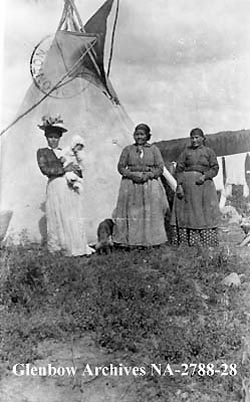
 Social Stratification Social Stratification
|
|


|
Cree women being visited by a white lady, Athabasca Landing, 1912.
|

The Indian's idea of a house is a different one to the trader's.
It is not a place to be lived in, but exists merely as a shield
from the weather . . . . A thin, pock-marked squaw invites me into a shack
or, more properly, into a baby warren which fairly bristles with
a flock of semi-wild children, for, as yet, the squaws have not
deliberately ceased from having children . . . . An unsavory mess of
entrails is stewing in a back pot and filling the house with an
unpleasant odour. I try not to show repugnance lest my hostesses
consider the white woman to be proud-stomached with no proper
appetite for lowly faring. (Note: This ethnocentric account of native life
is from a 1912 observation of the Landing by Janey Canuck [pen name
of Emily G. Murphy], quoted in Athabasca Historical Society 1986, 153)

 Cree family outside tipi at Athabasca Landing, 1912
Cree family outside tipi at Athabasca Landing, 1912
|
Half-breed money-scrip issue, Athabasca 1899.

|
 J.A. Cote, of the Scrip Commission and Father Lacombe
J.A. Cote, of the Scrip Commission and Father Lacombe
|
The upper class of Athabasca

|
 Two native women
Two native women
|

The swart boatmen are the most interesting feature of the place,—tall,
silent moccasined men, followed at heel by ghostlike dogs.
From this point north dogs are the beasts of burden; the camel may be
the ship of the desert, but the dog is the automobile of the silences.
The wise missionary translates his Bible stories into the language of
the latitude. As Count von Hammerstein says, "What means a camel to a Cree? I tell
him it is a moose that cannot go through a needle’s eye." The Scriptural
sheep and goats become caribou and coyotes, and the celestial Lamb is
typified by the baby seal with its coat of shimmering whiteness.
(quoted in Athabasca Historical Society, 155)

|
 Magnus Brown commanding Métis rivermen.
Magnus Brown commanding Métis rivermen.
|
Girls dressed up as RNWMP at Athabasca Landing

|
 Lunch at survey camp, Athabasca Landing
Lunch at survey camp, Athabasca Landing
|
Hugh Pearson, surveyor, Athabasca Landing

|
 Women visiting survey camp, Athabasca Landing
Women visiting survey camp, Athabasca Landing
|
Millie Hall and Louise Blane, Athabasca Landing, c. 1920s.

|
 Nellie Young at water pump Athabasca Landing, 1912
Nellie Young at water pump Athabasca Landing, 1912
|
Doctor O.C. Edwards and his tent, 1899.

|
 Gilbert E. Sanders gathering snow to make water.
Gilbert E. Sanders gathering snow to make water.
|
Gilbert E. Sanders dressed for moose hunt.

|
 Surveyors in Athabasca Landing area, 1909.
Surveyors in Athabasca Landing area, 1909.
|
Royal North-west Mounted Police, Athabasca, Alberta. 1914

|
 Billy Day, hotel bartender, guided moose in parade, 1909.
Billy Day, hotel bartender, guided moose in parade, 1909.
|
Moose hitched to sleigh at Athabasca Landing

|

Home |
The Hudson's Bay Company Post |
The Landing Trail |
Society, Gender, and Race |
Transportation Hub |
Boatbuilding |
To the Klondike |
The Commercial Boom |
Amber Valley |
The Athabasca Bore |
Agriculture and Settlement |
Then and Now
|
![]() Social Stratification
Social Stratification

![]()


















